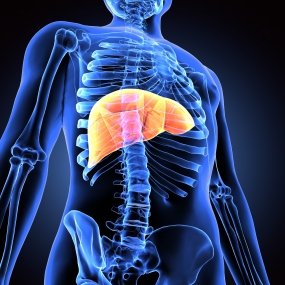Indicator for liver health status identified
A high-fat, high-sugar diet damages the liver in the long term. Scientists at the German Cancer Research Center (DKFZ) have now identified a characteristic change in the molecular signaling pathways of liver cells in mice that were exposed to such a diet for weeks. It fuels the division activity of hepatocytes and correlates with the risk of patients suffering liver failure after liver surgery
Chronic liver diseases are on the increase worldwide. This is mainly due to a high-calorie, high-fat and high-sugar diet. It damages the liver cells and promotes the development of fatty liver. If fatty liver disease, also known as MASLD (metabolic dysfunction-associated steatotic liver disease), persists, it can develop into metabolic dysfunction-associated steatohepatitis (MASH) and eventually degenerate into liver cirrhosis and, in the worst case, liver cancer.
"In order to stop this development, it is essential to understand the molecular mechanisms behind it," says Ursula Klingmüller from the German Cancer Research Center. "It is important to know indicators that help to assess the status of the pathological development."
A team from Klingmüller's department has therefore now taken a closer look at how the cellular signaling pathways of the liver change during this pathological development. To this end, the researchers examined liver cells from mice that had been fed a high-sugar and high-fat diet for weeks. This diet is considered a model for a Western diet. The animals in the control group were fed standard food.
The high-calorie diet led to an altered protein composition in the hepatocytes of the mice and to changes in the cellular signaling pathways. The signaling cascade of the liver cells starts with the growth factor HGF (hepatocyte growth factor), which is essential for the organ's ability to regenerate. The target molecule of HGF on the hepatocytes is the receptor protein MET, which belongs to the important tyrosine kinase molecule group. When the growth factor binds, MET is activated with a phosphate group. Phosphorylated MET stimulates cell division in hepatocytes.
After the weeks of the high-calorie diet, MET was particularly strongly phosphorylated in the hepatocytes of the animals. The division rate of the liver cells was increased - even in the absence of the growth factor HGF. Based on the findings, the team led by first authors Sebastian Burbano de Lara, Svenja Kemmer and Ina Biermayer established a mathematical model of the signaling cascade triggered by HGF. The model can explain how the HGF-triggered MET phosphorylation changes.
The researchers also examined tissue samples from patients who had had part of their liver surgically removed. They found that the lower the MET phosphorylation in the liver tissue, the better the patients survived the procedure. "At the first glance, this is a surprising result. The most likely explanation is that the proliferation of liver cells driven by high MET phosphorylation overloads the organ in the long term, so that it can no longer adequately perform its vital metabolic functions," explains Sebastian Burbano de Lara.
Study head Ursula Klingmüller adds: "The degree of MET phosphorylation is a measured parameter that provides important information about the severity of liver disease and the outcome of liver resection. The quantification of MET phosphorylation in surgical liver samples could provide an easily accessible indicator for predicting the clinical outcome of such operations."
Sebastian Burbano de Lara, Svenja Kemmer, Ina Biermayer, Svenja Feiler, Artyom Vlasov, Lorenza A. d'Allessandro, Barbara Helm, Christina Mölders, Yannik Dieter, Ahmed Ghallab, Jan G. Hengstler, Christiane Körner, Madlen Matz-Soja, Christine Götz, Georg Damm, Katrin Hoffmann, Daniel Seehofer, Thomas Berg, Marcel Schilling, Jens Timmer and Ursula Klingmüller: Basal MET Phosphorylation is an Indicator of Hepatocyte Dysregulation in Liver Disease.
Mol Sys Biol 2024, DOI: 10.1038/s44320-023-00007-4
With more than 3,000 employees, the German Cancer Research Center (Deutsches Krebsforschungszentrum, DKFZ) is Germany’s largest biomedical research institute. DKFZ scientists identify cancer risk factors, investigate how cancer progresses and develop new cancer prevention strategies. They are also developing new methods to diagnose tumors more precisely and treat cancer patients more successfully. The DKFZ's Cancer Information Service (KID) provides patients, interested citizens and experts with individual answers to questions relating to cancer.
To transfer promising approaches from cancer research to the clinic and thus improve the prognosis of cancer patients, the DKFZ cooperates with excellent research institutions and university hospitals throughout Germany:
The DKFZ is 90 percent financed by the Federal Ministry of Education and Research and 10 percent by the state of Baden-Württemberg. The DKFZ is a member of the Helmholtz Association of German Research Centers.


